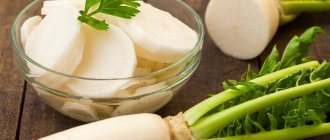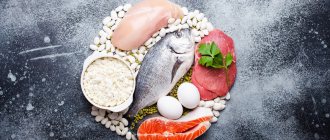Recently, a new fashionable word has appeared in cooking: “daikon”. In this article we will understand what it is and how to use it. Daikon is a type of radish that came to us from China and Japan. For Asian cuisine, this root vegetable is one of the most popular ingredients. And recently, the benefits of daikon have become known far beyond Asia, so radishes have spread throughout the world.
In appearance, the root vegetable is very similar to carrots, only it is white. Daikon has a sweet, slightly savory taste. Due to the low content of mustard oils, the root vegetable does not taste bitter. But the leaves are quite sharp, but after heat treatment they become pleasant to the taste.
Chinese radish grows in cool conditions. It is planted at the end of summer and harvested with the onset of cold weather. Daikon is increasingly becoming part of our daily diet. However, it is widely used not only in cooking, but also in cosmetology and medicine.
Useful properties of daikon
The benefits and harms of daikon have been studied for quite some time. Like most vegetables, daikon contains many beneficial substances. It is important to note that the vegetable is useful not only when fresh, but also when stored for a very long time. Daikon contains subgroup B vitamins, , , , , essential minerals, pectins, fiber, beta-carotene, enzymes and antioxidants. The vegetable is unique in that it does not have the ability to absorb harmful substances and salts contained in the soil. Therefore, the Japanese radish harvest is environmentally friendly and does not contain harmful components. Doctors recommend constantly including radish-based dishes in your diet. Daikon is versatile, you can add it to a salad, or you can make juice from it.
What are the beneficial properties of the vegetable? First of all, it cleanses the body. It can be used as a mild laxative and diuretic. Minerals such as potassium and calcium help remove excess fluid and waste from the body. Thanks to this quality, Japanese radish was introduced into the basis of proper nutrition and some diets.
Also, Japanese radish has a very positive effect on strengthening the immune system. The composition, rich in vitamins, strengthens the body's strength, and components containing protein and phytoncides cleanse the internal organs of bacteria and microbes. Regular consumption of daikon is an excellent prevention of colds. The vegetable promotes recovery and alleviates diseases such as bronchial asthma, bronchitis, and cough. It has a beneficial effect on the functioning of the liver and kidneys. The advantage of the vegetable is its pleasant taste. Anyone can drink a glass of juice, and it will improve the functioning of the pancreas.
In addition, daikon is an excellent sedative. It significantly affects the functioning of the nervous system, improving mood and reducing nervous excitability. Daikon juice, drunk at night, will give a person a full and healthy sleep.
Also, the benefits of Japanese radish are noticeable for diabetes, heart disease and problems with blood vessels. The properties of radish allow people with diabetes to normalize blood sugar. The vegetable also contains fructose, which is simply irreplaceable in the special diet of diabetics.
Daikon is no less useful for weight loss. It is a low-calorie vegetable, because 100 grams of the product contains only 18 kcal. As mentioned earlier, radish cleanses the body of toxins and waste, so the vegetable is simply irreplaceable in losing weight.
Radish is often used for cosmetic purposes. Freshly squeezed juice can relieve a person of freckles, age spots, acne and other skin inflammations. The juice can also be rubbed into the hair roots; it perfectly nourishes and strengthens their structure.
Chemical composition and calorie content
Daikon does not contain mustard oils, which are present in radishes and black radishes, and has a weak aroma. It contains vitamins, minerals and other beneficial substances.
White radish is rich in:
- vitamins of group B, A, PP, H, E;
- mineral components - potassium, phosphorus, selenium, manganese, iron, copper, iodine, sulfur, etc.;
- isorodanoic acid;
- fiber;
- enzymes that help digest starchy foods;
- pectin;
- carotene;
- enzymes;
- antioxidants.
The calorie content of the product is 21 kcal per 100 g.
Dangerous properties of the vegetable
Despite the many positive properties of the vegetable, daikon has some limitations and contraindications. First of all, this applies to people with stomach and intestinal problems. Due to the high fiber content, indigestion or pronounced flatulence may occur. It is also not recommended to consume daikon for people with ulcers and gastritis. Those who suffer from gout and kidney disease should not consume the vegetable. Also, people over 50 years of age should definitely consult a doctor before consuming vegetables. For certain chronic diseases and individual characteristics, the doctor will be able to recommend consuming vegetables in a certain amount.
Japanese radish should be consumed during pregnancy and breastfeeding only after consulting a gynecologist.
What it is
Daikon or white radish belongs to the cruciferous family. The taste is reminiscent of radishes, but more tender without bitterness and pungent odor. It has good taste: the upper part of the root vegetable is sweet, the lower part is slightly spicier. The shape differs depending on the variety - it can be conical or round. The pulp of varietal plants is white, in hybrids it has a light green tint. The vegetable weighs from 500 g to 2-3 kg. In Southeast Asia, the plant’s homeland, fruits weighing up to 15 kg are grown. In Russia you can find varieties that are bred specifically for cold climates.
Growing daikon
This root vegetable can be easily found on store shelves and markets. But everyone knows that home-grown vegetables will be much healthier than store-bought ones. Growing vegetables will undoubtedly appeal to everyone. Planting and caring for vegetables will not be any particular difficulty, since this vegetable crop is quite unpretentious. The only difficulty may be that not everyone is able to correctly calculate the time when to plant daikon. It can be planted both in the second half of summer and in spring. In summer, it is recommended to plant daikon in the middle zone.
There are a number of rules and recommendations that must be followed to ensure that the harvest is rich, tasty and truly healthy:
- soil preparation;
- sowing;
- watering;
- harvesting;
- storage.
First of all, it is important to properly prepare the beds. Although this plant is not particularly whimsical and grows quite well on various types of soil, it still loves loose soil. Therefore, before planting, the ground needs to be dug up and leveled. In order for the root crops to grow large, it is necessary to dig deep holes (about 10 cm) before planting. The distance between the holes should be sufficient (approximately 5-7 cm). The vegetable seeds are quite large, so they will sprout without problems. When to sow seeds in open ground? The ideal time to plant Japanese radish is April. One seed is planted in one hole, after which the soil must be moistened and covered with earth. To prevent slugs from appearing, the surface of the bed must be treated with ash. After thinning, the daikon should be fed with fertilizers. Only seedlings with a rounded root shape can be replanted.
Since root crops must remain in the soil until mid-September, they need additional watering. If there is a drought outside, then the daikon needs to be watered when the soil becomes dry. Abundant watering is not required, so if it rains, then nothing is needed from a person.
The fruits are collected until the end of September. Digging up daikon is not easy, but you can dig up the whole fruit only if you take your time. The planted root crop blooms and produces seeds. In order for vegetables to be preserved for a long time, they need to create special conditions. The air temperature in the place where the vegetable lies should be from -1 degrees to 5. It is recommended to store daikon in boxes with dry sand.
Plant pests are very similar to cruciferous diseases. It is difficult to fight them, but it is possible. First of all, you need to adhere to all the rules of agricultural technology: remove weeds, disinfect places where vegetables and garden tools will be stored, clean the area from plant debris. Some diseases are destroyed by chemicals. As a last resort, you can sprinkle the vegetables with them.
Simple radish salad
Vitamin explosion from available ingredients.
Ingredients:
- Fresh tomato – 2 pcs.
- Daikon radish – 1 pc.
- Dill – 1 bunch.
- Olive oil – 3 tbsp.
- Lemon juice – 1 tbsp.
- Salt - to taste.
Preparation:
Peel the radish and grate it on a coarse grater. Place in a colander to drain excess juice. Separate the tomatoes from the pulp. Cut the hard part into strips. Do not use the pulp, otherwise there will be a lot of liquid in the salad. Finely chop the dill. Combine everything, sprinkle with lemon juice, salt and oil.
Delicious recipes with daikon
There are many recipes for preparing various dishes with daikon. Due to the fact that it is a high-calorie product, it is used in all kinds of nutritional options. The calorie content of the vegetable is only 18 kilocalories per 100 grams of product. The most common recipes are salads. It is very tasty to combine daikon with carrots and apple, with carrots and chicken, with chicken and apple. Also a very tasty option is Japanese radish pancakes.
Daikon salad with carrots and apple
Best materials of the month
- Coronaviruses: SARS-CoV-2 (COVID-19)
- Antibiotics for the prevention and treatment of COVID-19: how effective are they?
- The most common "office" diseases
- Does vodka kill coronavirus?
- How to stay alive on our roads?
To prepare you will need 1 medium sized daikon, 1 carrot, 1 apple and a little mayonnaise. All vegetables must be grated, seasoned with mayonnaise and a little salt.
A wonderful option for the winter would be Korean-style daikon. It is prepared quite simply.
To prepare this preparation you will need: 2 daikons, 750 grams of water, a quarter glass of salt, a quarter glass of sugar, a quarter glass of vinegar, a quarter teaspoon of turmeric. Japanese radish must be washed well, peeled and cut in any way: cubes, quarters, rings. The main thing is that the pieces can fit into the jar. Next you should prepare the marinade. To do this, add salt, sugar, turmeric to boiling water (250 grams) and mix everything. Next, you need to add the remaining water and leave everything at room temperature. After the turmeric has dissolved in the water, you need to put the daikon pieces in a jar. Add vinegar to the marinade, stir and pour over the daikon. If necessary, you can add more water to the marinade. The jar should be closed with a tight lid and stored for about 4 days in a cool, dark place. Then the finished Korean daikon can be stored in the refrigerator, but the shelf life of such preservation is no more than a month. To make the turmeric color the vegetable, you can shake the jar periodically.
Daikon with cucumber
The salad is very easy to prepare. For it you will need onions, raw daikon, cucumber, vegetable oil, salt and pepper. Onions and daikon should be peeled and washed, cucumbers should also be washed well. Next, the daikon and cucumbers are grated, the onion is finely chopped, everything is mixed, seasoned with oil and spices. Thus, a healthy, quick and very tasty salad will be ready.
More fresh and relevant information about health on our Telegram channel. Subscribe: https://t.me/foodandhealthru
We will be grateful if you use the buttons:
Asian salad
A dish for spicy lovers
Ingredients:
- Sweet pepper – 1 pc.
- Carrots – 1 pc.
- Daikon – 1 pc.
- Fresh cucumber – 1 pc.
- Ginger – 30 gr.
- Chili – 0.5 pcs.
- Sesame oil – 3 tbsp.
- Soy sauce – 1 tbsp.
- Lemon juice – 1 tbsp.
Preparation:
Prepare a sauce from sesame oil, lemon juice, chili pepper, ginger and soy sauce. Stir and set aside. Cut bell peppers, radishes, cucumbers and carrots into thin strips. Mix everything in one dish, pour over the sauce and serve. Bon appetit.
Benefits of eating root vegetables
Each product has both positive and negative properties. In the case of daikon, experts note that the product is not recommended for use by people suffering from the following diseases:
- Stomach ulcer.
- Gastritis.
- Flatulence.
- Colitis.
Even a small portion of root vegetables can harm such patients. Fiber can damage the intestinal walls, which are already inflamed due to the disease. In some cases, complications after taking the product can be serious, even fatal, if doctors do not have time to help the patient.
There are other restrictions. First of all, this concerns individual intolerance. It is also undesirable for patients with diagnosed gout, thyroid problems and urolithiasis to use the plant.
Even a healthy person, excessive passion for daikon can be harmful. Frequent consumption of the plant in large quantities leads to abdominal pain, diarrhea, nausea and vomiting.
Unlike black radish, this root vegetable does not contain mustard oils. It can be stored for several months, and the content of useful substances in it does not decrease at all.
And there really are a lot of them here. Thus, Japanese radish is rich in substances that are so beneficial for the human body, such as fat-soluble vitamins A and E, a full “line” of group B vitamins.
Not without the famous vitamin C and nicotinic acid. There are carotenes, enzymes, enzymes and coarse fiber.
Japanese radish has a rich set of beneficial microelements. It contains iron and potassium, zinc and calcium, fluorine, phosphorus, copper.
But Japanese radish is not only powerful in medicine. Women actively use it for cosmetic purposes.
For hair. Fresh juice is rubbed into the roots to keep the mane healthy and strong. After literally 5-7 such procedures, a natural, beautiful shine appears, dandruff disappears, and the hair itself grows faster.
By the way, your nails will not be left out of attention when eating Japanese radish. A high calcium content was found in the pulp. This allows bones and nails to remain strong.
For skin. Daikon juice, along with parsley decoction, perfectly lightens freckles and age spots. It is also used to lubricate problem skin prone to acne. There are cases when traditional medicine cured even old boils by applying bandages soaked in Japanese radish juice.
Diluted juice promotes rapid healing of wounds, cuts and scratches. You just need to lubricate the damage several times a day. Or simply apply a loose bandage with a bandage soaked in juice.
By the way, not only external lubrication with juice is suitable for cosmetic purposes. There is a recipe for a salad made from daikon and other vegetables. It's called "Beauty Bomb". Those women who ate a serving of this salad every day noted that within a week their skin condition noticeably improved. Small wrinkles disappeared and complexion evened out. The skin itself has become matte and velvety, looking younger. Try to become more beautiful just by diversifying your diet.
benefits and harms of red onions
Despite the wide range of positive effects, daikon has contraindications. And very serious ones. It is strictly forbidden to be consumed by people with diseases of the gastrointestinal tract:
- gastritis
- stomach ulcer
- colitis
- flatulence
Because even a small portion can cause severe harm to the body. Up to death if you do not have time to help in time. Coarse fiber fibers greatly irritate already inflamed organs. Hence the harm. There are cases when doctors who arrived by ambulance simply did not have time to save a person.
By the way, even an absolutely healthy person is not recommended to get too carried away with daikon. Because overeating threatens:
- abdominal pain
- vomiting
- pain in the stomach
- temperature rise
- chills
- diarrhea
In this case, all symptoms occur very quickly and simultaneously. Although, gluttony even without daikon only brings harm. Therefore, eat this wonderful root vegetable a little at a time, and you will be happy.
health benefits and harms of iceberg lettuce
The word "daikon" is translated as "Japanese radish." The vegetable is also called "big root". This name was given to it because of the large size of the fruits. They can reach 40 cm in length and 700 g in weight. The vegetable grows well in temperate climates.
It has a pronounced aroma and mustard taste. The root vegetable is included in the daily diet of the Japanese. It is consumed both fresh and cooked. This demand is due to the following beneficial properties of daikon:
- prevention of respiratory diseases due to phytoncidal properties;
- normalization of the nervous system;
- restoration of thyroid function;
- strengthening hair, nails and teeth;
- whitening property;
- assistance in weight loss;
- improvement of brain activity;
- treatment of skin diseases;
- diuretic and laxative effects on the body;
- strengthening the immune system;
- improving the composition of seminal fluid;
- normalization of urination.
Daikon has a general strengthening effect on the body. First of all, it restores the immune system, replenishing the supply of vitamins and minerals in the body. In folk medicine, it is often used to eliminate hangover syndrome. The root vegetable is able to remove toxic substances from the body resulting from the breakdown of ethyl alcohol.
For anemia, the product is usually consumed together with carrots and beets. This combination improves well-being and restores iron levels in the body. In some cases, Japanese radish juice is used as an antiparasitic agent. It is often used to prevent gelosis. The particular importance of the product is noted in relation to the functioning of the digestive system. It increases the number of beneficial bacteria, which has a positive effect on the food processing process.
The benefits of daikon for the human body are expressed in its rich vitamin composition. But with excessive consumption of the product, even Vita can be harmful to health. This is due to the high content of fiber and various acids. Due to them, the product has an irritating effect on the mucous membrane of the digestive organs. Stool upset, nausea and abdominal pain may occur.
Warning! In some cases, an allergic reaction develops due to overeating.
Daikon is in demand not only in cooking, but also in folk medicine. It is taken orally and applied locally to the skin. Daikon effectively relieves cough and other symptoms of colds. Root juice mixed with honey helps remove mucus and makes breathing easier.
When losing weight, Japanese radish is used to satisfy hunger and activate metabolic processes. It improves the digestibility of food, preventing fat deposition.
For rheumatism and radiculitis, daikon pulp is applied to the problem area for several hours. This eliminates pain and discomfort. For gout, daikon is mixed with honey before applying to problem areas. Such manipulations help prolong the period of remission and strengthen the body during an exacerbation of the disease. Japanese radish is able to remove excess salt from the body and normalize joint function.
The root vegetable is also distinguished by its ability to accelerate tissue regeneration. This allows you to deal with cracks and scratches on the skin. For trophic ulcers, chopped radish is mixed with butter. Very often, daikon is used to cleanse the liver. It removes toxins and excess cholesterol from it. As a result of this, the digestion process is normalized and heaviness in the right hypochondrium disappears.
For cosmetic purposes, the product is often used to create masks that eliminate age spots and freckles. The effect is achieved due to the bleaching properties of the root vegetable. In this case, it is enough to hold the daikon pulp on the skin for 15-20 t.
The vegetable is often used to eliminate acne and acne. Before applying to the skin, the crushed root vegetable is mixed with aloe juice or sour cream. Daikon juice is often used instead of a cosmetic toner. It has an antibacterial effect, which is important for the prevention of various rashes. Therapeutic toner reduces the number of wrinkles and improves skin elasticity. It is recommended to do home treatments using daikon 1-2 times a week.
Root vegetable gruel is often used to improve hair structure. It is distributed over the strands and left for 20-25 tons. Regular use of this mask ensures the appearance of shine on the hair and enhances its growth.
In some cases, it is advisable to limit the consumption of vegetables. This will help maintain health by avoiding unwanted reactions from the body. Contraindications include the following:
- stomach ulcer;
- kidney diseases;
- liver dysfunction;
- increased stomach acidity.
Excessive consumption of daikon risks the development of an allergic reaction. Most often it manifests itself in skin rashes. Therefore, the root vegetable must be consumed strictly in therapeutic doses. There is also a chance of diarrhea and bloating. If a person has diseases of the digestive system, daikon can cause abdominal pain. This happens when eating root vegetables on an empty stomach.
Important! The duration of therapy using daikon should not exceed 3 months.










